Why did the world break in the early 2010s?
Geopolitical, economic, political, and technological factors.
A lot of Americans these days have the sense that the world they grew up in has been broken. And although people identify different years as the breaking point, it’s usually between 2012 and 2015.
For many, the key shift was the domination of bitter online politics over daily life:
There was a shift around 2015 where the "online" world spilled over into the real world and the way we view/treat each other changed. After 2015 things in everyday life started to go through the political lens. We started to bucket people and behaviors along the political spectrum, which was largely an online behavior pre-2015. We started judging everyone as left or right, or we walked on eggshells to avoid it. Before that, you knew your neighbor was Republican or Democrat based on their lawn signs, but it had little bearing on your daily interactions or behaviors. And it only seemed to matter every four years for a few months. Now it's constant and pervasive. And pre-2015 we had phones and social media, but there was more of a boundary, and most people would "log off" most of the day. The dopamine addiction, heightened by the polarization, was much lower. Only fringe message board and twitter posters spent their days arguing online, now it's everywhere, and there's no real boundary.
I also remember the moment it felt to me like the old world had broken. But strangely, it wasn’t about online politics at all. I was sitting in an Airbnb in Tokyo in March 2014, not too different from the hotel room I’m in right now, reading the news on my laptop. And I saw the headline: “Russia annexes Crimea.”
Russia had invaded Ukraine a few weeks earlier, but this headline stunned me. Not since World War 2 had a great power conquered and annexed part of an internationally recognized foreign nation. Russia’s action went against every principle of international sovereignty that had been created in the aftermath of that great war, with the help and assent of the Soviet Union. And it seemed very clear that President Obama and the European leaders were going to do basically nothing about this, other than to levy some ineffectual sanctions. Russia had called the bluff of the post-WW2 order, and now that order was gone.
What’s interesting is that this calamitous feeling — that the world I had grown up in was being swept away — wasn’t really related to wokeness, or Donald Trump, or social media, or any of the factors that people (including me) typically associate with the ruptures of the 2010s. But of course I felt those changes too, just a few months later — Gamergate and the Ferguson protests in the summer of 2014, and the rise of Trump a year later.
Looking back, it’s easy to see that the early to mid 2010s — the period between 2012 and 2015 — was a turning point in both American society and world events. Figuring out why is harder. As far as I can tell, it was a lucky confluence of several events — technological, economic, political, and geopolitical.
The geopolitical break
Russia’s decision to invade Ukraine was just one step in a long chain of events. As Russia’s economy revived from the chaos of the 90s on the back of high oil prices, Putin launched an increasingly bolder series of wars that we now know, with hindsight, were aimed at restoring some facsimile of the glory of the old Russian Empire. First Chechnya, then Georgia in 2008, then Ukraine in 2014 and again in 2022. The 2014 invasion just happened to be the first one that crossed a major red line of the post-WW2 order.
The even bigger geopolitical event — although few realized it at the time — turned out to be the ascension of Xi Jinping in November 2012. Before Xi, the CCP looked like it had developed a stable succession mechanism, but this was actually fake; both Jiang Zemin and Hu Jintao had been pre-selected by Deng Xiaoping. Xi was the first who had to fight his way to the top, and he did so by brutally crushing his rivals. Xi represented a break with the China that Deng had created, and in retrospect it turns out to have been a pretty dramatic break.
China didn’t change overnight under Xi; the early years of his rule felt, at least to an outside observer, like a continuation of the Hu Jintao era. But Chinese people themselves knew better; they could see the society around them beginning to grow more repressive. Xi shifted to a much harsher policy toward the Uyghurs and other minorities, began to undo the advancement of various freedoms that had occurred under his predecessors, cracked down on civil society, and imprisoned many of his rivals in the name of “anti-corruption”.
Xi’s policies didn’t create China’s prosperity; Deng’s did. What Xi really did in the 2010s was to take China’s newfound economic heft and start to use it to push against the existing global order. Whereas Deng and his chosen successors had adhered to the principle of “hide your strength and bide your time”, Xi switched this slogan to “great changes unseen in a century”, meaning that China should displace the developed democracies as the global hegemon.
So during the 2010s, China steadily began taking more aggressive steps against its neighbors, asserting ownership over the South China Sea, pressing its claims to various bits of its neighbors’ territory, and trying to create new China-led international institutions as alternatives to the existing ones that had been created after WW2. And Xi created an ever-closer informal alliance with Vladimir Putin; this was absolutely essential for Putin’s decision to invade Ukraine.
These events ended the hegemony of the U.S. and its European and Asian allies. But even more importantly, it upended the notion that we lived in a world defined by the resolution of World War 2. The Soviets, despite challenging the U.S., had been a status quo power — the victors of the last great world war. They had helped create and sustain the UN and a number of the other postwar institutions, and they had maintained the norm of “no territorial conquest”. Xi and Putin gradually made it clear that they were different — that they intended to revise the post-WW2 arrangement. Russia’s intent to do this became apparent in 2014, and China’s during and after the pandemic.
For most Americans, this tectonic geopolitical shift didn’t immediately make itself felt during the 2010s. The Iraq War probably had a much bigger effect on Americans’ perceptions of their own country’s international decline. It was only those of us who were paying attention to the headlines who realized that the world had changed, and that it might be sliding toward a new great-power conflict. But for those of us who did realize that, the world became suddenly scarier.
The economic break
For Americans, the big economic break didn’t come in the early 2010s; it came in 2007-9. House price appreciation stopped and went into reverse, middle-class wealth collapsed, and we had the biggest recession since the Depression. But while that recession was raging, simply getting out of it absorbed most of our attention and energy. It wasn’t until the end of 2011 that employment started to recover:
You could see this recovery in other measures too, like GDP. For income, the recovery began in 2013:
And for wages it began in late 2014:
The beginning of the economic recovery didn’t immediately reverse the damage that had been done from the crisis and the recession. But once it became apparent that things were on the mend, Americans may have felt they could turn their attention to more long-standing economic problems — the long rise in inequality, the stagnation of wages, and the decline of upward mobility since the 1970s.
Those problems had existed during the 1980s, 90s, and 00s, but in some sense they had been “masked” by rising middle-class wealth from the long real estate boom, and by rising family incomes from the advent of two-earner families. The Great Recession saw an abrupt end to both of those trends. Middle-class wealth collapsed while the wealth of the rich kept rising:
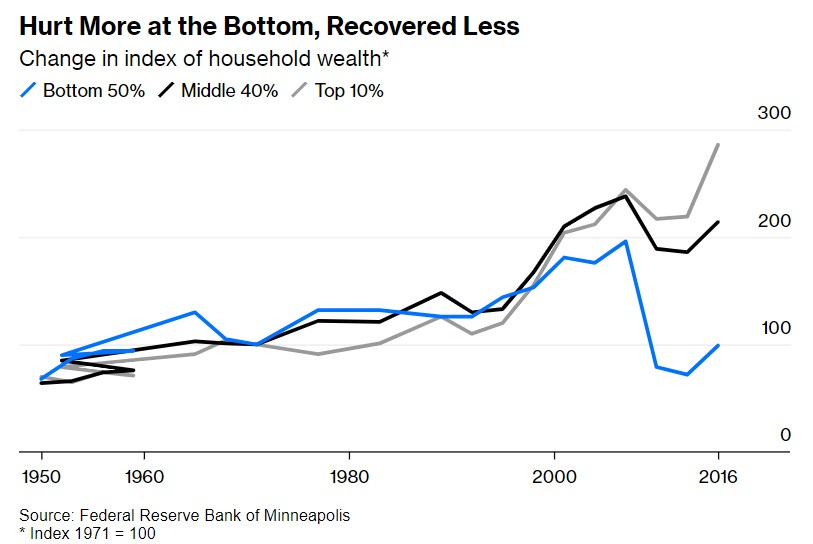
And while housing prices and middle-class wealth would later recover, the rise of two-income households can only happen once. Women’s employment topped out around 2000:
So it’s possible that the 2010s saw the sudden outpouring of economic disappointment, anger, and ennui that had been building up since the 1970s.
The political break
In the 1980s and 1990s, politics in America was primarily about ideology — an alliance of libertarian businesspeople and Christian conservatives against working-class voters and cultural liberals. There was a racial angle there — Black voters broke very strongly for the Democrats, while Southern White voters went strongly Republican. But for the most part, ideology dominated.
That probably made Americans relatively comfortable about the country’s increasing diversity. The 80s, 90s, and early 00s were a period of mass immigration, mostly from Latin America but also increasingly from Asia. In 1980, White Americans were 80% of the population; by the early 2010s it was down to around 60%, almost entirely as a result of the Latino and Asian increase.

But until the early 2010s, the political implications of this shift weren’t clear. As late as the 1990s, Asians still tended to vote more Republican than Democratic. And Latinos trended toward the GOP in 2000 and 2004, until they appeared to be almost evenly split. Both Asians and Latinos voted more Democratic in 2008, but so did working-class Whites; everyone was angry about the financial crisis and the Iraq War.
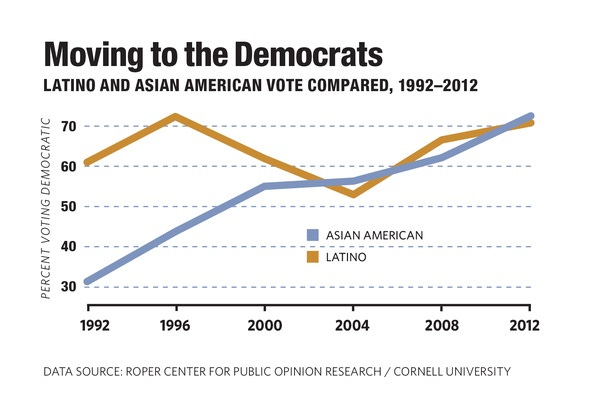
Muslims used to break for the Republicans as well.
But in 2012, the shift of Latino and Asian voters toward the Dems became pronounced. Much of the working-class White support that Obama had enjoyed in 2008 evaporated in 2012, but he still won reelection fairly comfortably. And this was despite the fact that the GOP ran Mitt Romney, a consummate moderate!
That set alarm bells ringing in Republican heads. They started to pay more attention to a thesis that had been around since at least the early 2000s — the idea that immigration and increasingly racialized voting patterns would create a permanent Democratic majority in the U.S. electorate. Democrats started paying more attention to this idea too, and it made some of them feel triumphalist about the future.
If voting patterns are racial rather than ideological in nature, it means that politics becomes a war of demographics. If POC voters can never be persuaded to join a political coalition with White voters, and vice versa, it means that outnumbering the other racial bloc, or disenfranchising them, is the only way to ensure victory for either bloc.
That is a dark and terrible thought indeed. The 2012 election didn’t prove we were living in that sort of racial zero-sum-game, but it suggested that this might be the way we were heading. While some in the GOP still dreamed of persuading Latino and Asian voters to come back, an increasingly sizeable bloc concluded that restrictions on immigration were essential to the party’s future. That conviction still dominates thinking on the Right, despite clear signs that racial polarization is falling and Latinos, along with some conservative Asian and Black voters, are drifting back toward the Republicans.
Among progressive activists, the racial polarization of the 2012 election probably contributed to the increasingly popular idea that Black, Latino, and Asian voters are all bound together in a social and political coalition. Some progressives believe that this coalition extends beyond mere electoral trends, and encompasses art, culture, hiring, promotions, and so on.
This is a mindset that I’ve called a “cold civil war”. If America will be not just dominated but defined by one of two implacably opposed racial blocs that will squeeze the other out of all levers of cultural, economic, and political power, it means we no longer live in a shared nation, but rather a raging battlefield. That was the mindset that seeped into many Americans’ thinking in the 2010s. Trump definitely seemed to validate the idea of America-as-race-war, but the 2012 election was the point at which I saw people start talking about the idea openly. An analysis of the words Americans used to talk about politics suggests that my impression is correct:
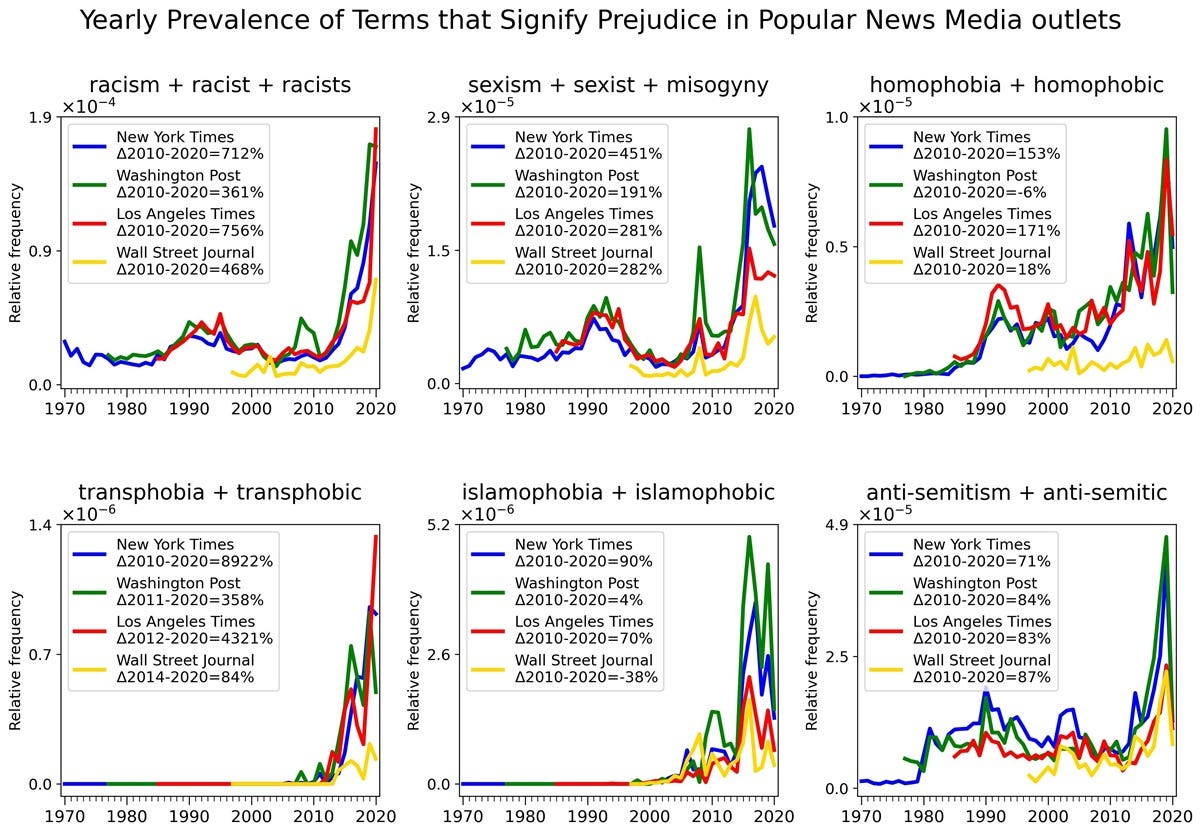
The technological break
It’s possible that all these political and economic ructions would have stayed in the background of most Americans’ consciousness, confined to the realms of CNN and newspaper op-eds and message boards But in the early 2010s, Americans got a new technology that allowed them to stay engaged with social and political discussions every hour of every day, no matter where they were. The advent of the smartphone, equipped with social media platforms like Twitter, put the continuously raging maelstrom of politics in everyone’s pocket, just a thumb press away.
A lot of people downplay the technological changes of the early 2010s, because productivity didn’t go up by much, and because the physical environment wasn’t really transformed. But the combination of smartphones and social media represented a dramatic break with the ways that humans had learned — or even evolved — to interact over long millennia. The evidence — both circumstantial and experimental — is piling up that the nexus of smartphones and social media is behind the marked decline in well-being that began in the early 2010s.
Erik Hoel has a very good post with a lot of graphs showing a break point right around 2012-2015:
You should really read the whole thing, but I’ll just post a couple of relevant graphs that show the suddenness of the break point. Here’s teenage depression:

Here’s in-person socialization:
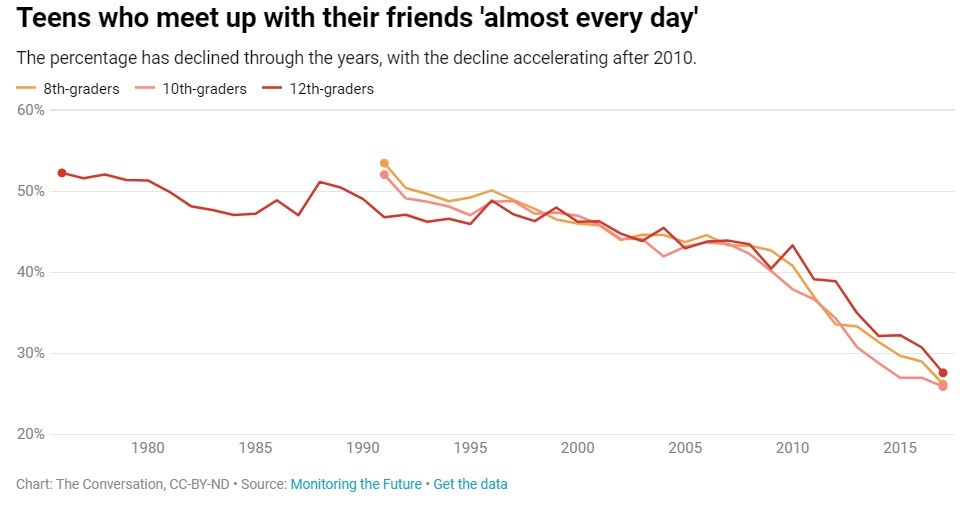
And here’s fertility:
These changes were less pronounced outside of the U.S., but there’s experimental and circumstantial evidence that social media has similarly negative psychological effects in other countries. And the recent acceleration of the decline in fertility rates seems to be a global phenomenon.
A perfect storm
In the end, I can’t easily dismiss any of the technological, political, or economic factors here. It seems like the feeling that the world broke in the early 2010s emerged from a perfect storm. Smartphones and social media arrived just in time for Americans to rage at each other over the country’s increasingly racialized politics and the built-up economic stresses released by the Great Recession.
Whether America can put itself back together after that storm, or what that new country will look like, is still an open question. Racial polarization is falling, and there are many signs that Americans are starting to turn away from identitarian conflict. Meanwhile, wages have been steadily growing again, inequality has plateaued, and middle-class wealth has recovered. And there are signs that Americans are starting to turn their backs on the most divisive social media platforms and partisan news outlets.
The real X-factor here is geopolitics. Even if America slowly knits itself back together, there will be no restoring the American-led democratic hegemony that existed before Xi and Putin. And the political weakness that we’re now experiencing as a hangover from the ruptures of the 2010s will probably make us far less nimble and decisive in terms of responding to the new global authoritarian challenge.
So when we look back on the early 2010s a decade or two from now, we may remember that this was the time the world truly broke…but for very different reasons than we thought at the time.


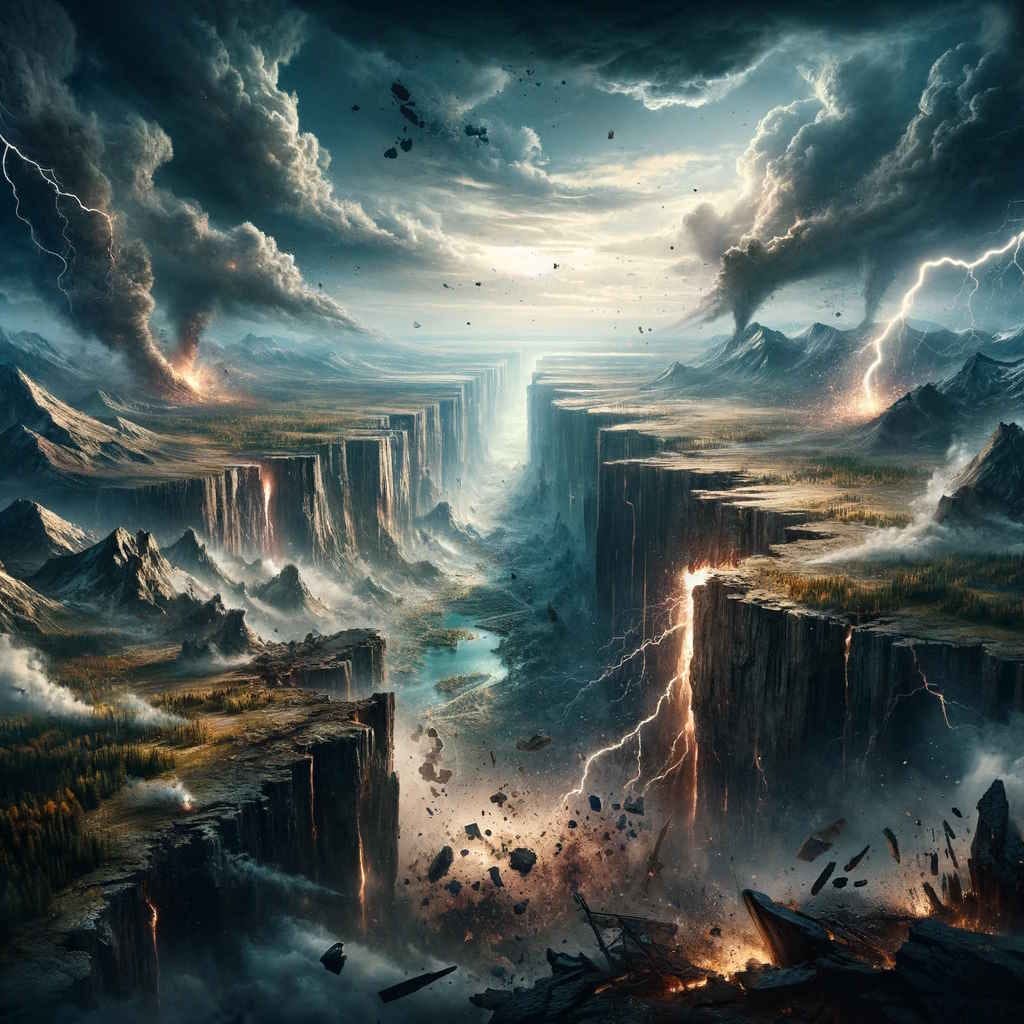







I went to grade school when Eisenhower was President. My personal life observations see and agree with the data but some things are missing.
In the 1950s and 1960s, as kid, you've heard we had nuclear air raid sirens, drills, crawl under the desk, the Soviets were going to kill us all amd the world. The terror kids felt waking up at night figuring out the survival tactics of living in a nuclear winter with radioactive snow 3 inches deep, is unimaginable and was not much imagined by kids of the 80s 90s and on.
Assassinations. As crappy as Trump, his insurrection, his MAGA serviles, it is a far cry from the days President Kennedy, Martin Luther King and Bobby Kennedy were assassinated. Unique in all American history that decade. The social foundation of decency was deeply wounded.
The 1950s, 60s amd 70s,brought the greatest social change ever in America. Putting back into law Lincoln's goals. Millions of lives saved by US regulations on cars and industry.
Then Reagan. There are some Baselines in your charts that begin inflection in the 1980s. Looking back, we see the insidiously bad policies of conservatives. The vilification of women of choice. The demonization of the left. The Acolyte of Hate, Limbaugh spewing division and literally making enemies of others.
Hate and division were intended drives of the Moral Majority, Falwell, NRA - Lapierre, Beck, Gingrich et al.
I believe things pre exist and needs are latent waiting to be stimulated by products, services etc.
Twitter and social media played to latent needs, they didn't create these. They were the Amplifier of these.
I just have a hard time with the tweet that leads off. We had the fall of communism. A terrible war in Eastern Europe. Enron. 9/11 and the War in Terror. The financial crisis. The first Black President. A seismic shift in how people viewed gay rights. I feel like a lot changed in those decades, some for the better, some worse, but I just don’t feel like my world, at least, as a professional city dweller in a blue area, seismically shifted more in the 2010s than any other time.